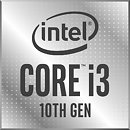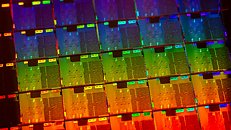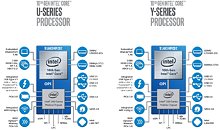Tuesday, May 28th 2019

Intel 10th Generation Core Case-badges Revealed
Intel laid rest to speculation that post 9th generation, it could replace its Core brand with something else. The 10th generation Core processors, built around the 10 nm "Ice Lake" microachitecture, will feature the first noteworthy IPC increments since "Skylake" thanks to their new "Sunny Cove" CPU cores. These will also feature DLBoost, a fixed-function matrix-multiplication hardware that speeds up deep-neural net building and training by 5x, as well as certain AVX-512 instructions. The cores will be optimized to cope with 2.4 Gbps 802.11ax Wi-Fi and faster Ethernet standards. The first of these chips will target mobile computing platforms, and will be quad-core parts like the dies pictured below. To save notebook PCB real-estate, Intel will put the processor and PCH dies into a multi-chip module. It will be quite a wait for the desktop implementation, but at least you know what their case-badges look like.





55 Comments on Intel 10th Generation Core Case-badges Revealed
If they want investors and consumers to stay with them, they need nothing less but a new architecture that would soundly beat Ryzen 3xxx series.
2002 - 130 nm
2004 - 90 nm
2006 - 65 nm
2008 - 45 nm
2010 - 32 nm
2012 - 22 nm
2014 - 14 nm -------|
2016 - 14 nm -------| ---> FAIL
2018 - 14 nm -------|
come on get back up and fight that AMD !
you know, I just want you guys fight and beat each other to death so I get either your CPU or AMD for cheap
This market is much bigger than desktop PCs and it is where AMD has less representation.
They have said this countless times, they cannot replace 14NM with 10nm in desktops because who would buy a 8700K with 20% less performance ?
But it still nothing i am impressed by. Still quad-core yawn:wtf:. Wake up intel, its 2019 and not 2012. Quad-core cant really impresse any one these days.
Plus, Intel and AMD have been indirectly charging you $100 for hyperthreading/smt, know why? because it comprises 25% more multithreading performance, for example, the 9700k and 9900k.
The difference here is 342 points, that is 20 - 25% or so performance for hyperthreading.
Interesting enough reviews even here at tpu says that the 9900k consumes only 10% more power, in my and many other tests around the world differs from these reviews in that sense.
Do you really believe the 9900k consumes only 18 watts more than the 9700k, 100% multithreading? test it on intelburntest and see yourself your house burn together hehe
I made tons of tests with nehalen when hyperthreading came to exist, i7 920 used 350 watts with hyperthreading, without hyperthreading, around 180 watts and the same 25% multithreading performance that was at that time and the interesting thing was that, hyperthreading off my i7 920 4.2ghz used 1.18v stable 24/7, hyperthreading on used 1.40v stable. So I dont believe these numbers reviews throw on people regarding power consumption while hyperthreading is enabled.
The first generation 10nm is not good enough for highly clocked chips and high yields, so it makes sense to use it for low power chips. And as you say, in terms of quantities, these low-powered mobile chips will ship in high volumes.
10nm+ has been delayed to next year, with Intel promising Ice Lake-SP shipping in Q2 2020.Intel "10nm" is comparable to TSMC's "7nm", these are just marketing names.
Intel were the first to ship products on this generation of high-power nodes; low volumes of Cannon Lake since April 2018 and I believe some FPGAs. In this quarter they will ship larger volumes of Ice Lake-U and Ice Lake-Y, but still only relative small chips. To date, AMD have shipped the largest chips on this new generation of nodes, but still no larger volume until Zen 2 starts to ship in Q3.
TSMC "7nm" seems to be in better shape than Intel's "10nm", so in that regard Intel is "behind", but not because of the naming.A quad core with this performance level and low TDP is unmatched and quite impressive.